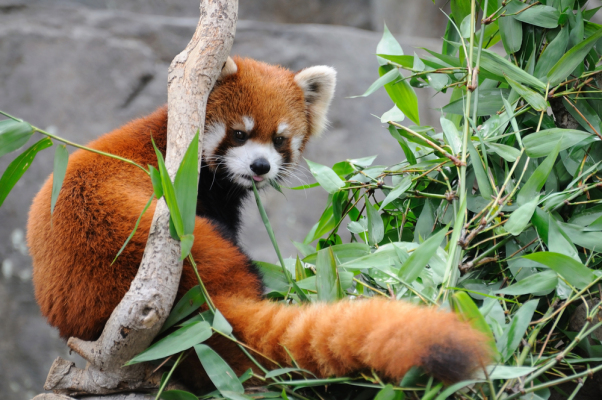
With its thick russet fur, bushy striped tail, and kitten-like face, the Red Panda(Ailurus fulgens) is one of the Himalayas’ cutest inhabitants. It was first described by a French zoologist in 1825 – 48 years before the Giant Panda was ever catalogued. Although sometimes referred to as “the Lesser Panda,” the Red Panda is actually “the first panda.”
Although often associated with bears and raccoons, Red Pandas are members of their very own taxonomic family(Ailuridae). Sadly, deforestation and poaching for pelts threaten the existence of this entirely unique species. Over half of the wild Red Panda population has been lost in a mere 20 years.
Although unrelated to the Giant Panda, the Red Panda does share a distinct similarity. It is believed the name “panda” originated with the Nepali word “ponya,” meaning “bamboo eater.” The eager consumption of this plant is a defining feature of both pandas. In fact, both pandas also possess a pseudo-thumb (a modified wrist bone) specially used for grasping bamboo.
Despite its largely vegetarian diet, the Red Panda is classified as a carnivore because it also eats eggs, small birds, insects, and small rodents. Nevertheless, bamboo still makes up 90% of its diet.
| Length | 50-64 cm(1’8″-2’1″) |
| Tail Length | 28-59 cm(11″-1’11”) |
| Weight | 3-15 kg(6.6-33 lbs.) |
Habitat
High-altitude, temperate forests with bamboo understories are the preferred hangout of the Red Panda. Almost 50% of their habitat is in the Eastern Himalayas, although they can also be found in Myanmar, China, Nepal, India, and Tibet.
Red Pandas are well suited for the forest as they are excellent climbers. They can quickly reach the top of a tree to escape predators like Snow Leopards. Red Pandas also perch in the treetops to sunbathe. Their fluffy tails help them balance as they climb and are also used like blankets, providing protection during cold or harsh weather.
Behaviors
Roughly the size of a house cat, Red Pandas sometimes act like them, too.
They aren’t very active during the day, preferring to sleep through the heat and conduct their business around dawn and dusk. They groom themselves by licking their paws then cleaning their fur, even “washing” their faces with their paws.
Like cats, Red Pandas also have claws which are used for both climbing and defense. The Red Panda will also stand on its hind legs and release a potent odor to further deter predators.
Reproduction and Development
Breeding season takes place from January to April, but Red Panda females are only fertile for a day or two. Red Panda mothers usually nest in tree hollows, periodically moving to new dens for safety. Cubs start off with gray fur, but start morphing into a cinnamon hue around the time they stop nursing.
Communication
Red Pandas are largely solitary creatures, usually only meeting together around breeding season. Nevertheless, they have a variety of sounds to communicate with when they do interact. They have been known to squeal, audibly exhale, bark, twitter, and bleat. Cubs let out high pitch whistles when in distress. Visual cues include head bobbing and intense staring. Red Pandas also use scent-marking to denote their territories.
Conservation
The Red Panda is classified as endangered, facing a high risk of extinction in the wild. Scientists have estimated there to be only 2,500 Red Pandas left roaming in their natural habitat. Thankfully, there are efforts in place to save the Red Panda, such as the creation of designated protected areas, which also serve to protect an entire ecoregion. You can help by supporting conservation efforts either financially or by recycling and volunteering to help clean your local ecosystems. This helps keep air and water unpolluted, thereby supporting species around the world, including your fellow man.
Lifespan
A Red Panda can live up to 23 years.
In Pop-Culture
Red Pandas have not appeared in many works of fiction, but Master Shifu (voiced by Dustin Hoffman) from Kung Fu Panda is a fun representative of this unique species. Pabu, the “fire ferret” from The Legend of Korra, is heavily inspired by the real “fire fox,” and the Mozilla Firefox logo depicts a Red Panda.
